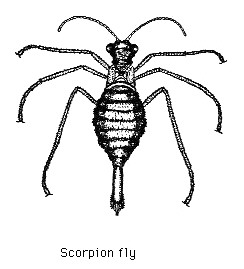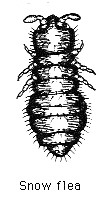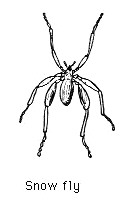Snow
Critters
by
Bill Amos,
Vermont,
US
Winter brings stress, crisis, behavioral and metabolic languor
to most wild creatures. Some, like summer birds and a few
butterflies in search of warmer climes, avoid harsh conditions by
leaving the north, while many resident animals hibernate in
winter-long torpor. For others, life is over by the end of
summer, their legacy left in protected eggs. Mammals, active or
asleep, grow thick insulating coats, and spiders and insects
descend from treetops to find shelter close to the ground.
Earthworms, toads, salamanders, and reptiles seek refuge as far
underground as possible where, with altered lifestyle, their body
fluids become resistant to freezing.
Birds that remain in the north cram themselves at our feeders.
Chipmunks, woodchucks, and bears sleep in their winter quarters,
and deer hunker down in protected forest glades. Grasshoppers and
field crickets vanish completely, leaving only their eggs in the
soil, while mole crickets (and moles themselves) dig deep beneath
the frost line. Although torpid wasps remain more or less
isolated in nests or sheltered crannies, bees in their hives and
ants in subterranean chambers huddle together where the slowed
metabolism of their combined body mass is sufficient to generate
a bit of warmth.
There is only one cardinal rule for animals in winter:
survive.
Winter not only brings rigors, it brings solutions too. In the
depth of winter, life is everywhere around us—on, in, and
beneath snow. Life of many kinds remains plentiful under
ice-covered ponds and streams. Snow and ice are superb insulators
for plants and animals underneath. Small creatures may not be in
evidence, but all we need do is look in the right places.
It is no surprise that moths and butterflies survive the
winter under conditions other than as adults; they exist as eggs
and in immature stages. What truly startles is the sudden
fluttering of a small moth across the snow on a mild February
day. You might even come across a conspicuous Mourning Cloak
butterfly hibernating in an unheated shelter. I discovered one in
my garage last winter.
 The usual winter
evidence of moths and butterflies is either a dormant caterpillar
or a transformational pupa, bare or wrapped in a silken cocoon.
Larvae and pupae of all sorts of insects are found in forest
litter, in chambers deep in the earth, tucked into the inner
recesses of an old stone wall, burrowed into last summer's plant
stalks. If you seek insects in the rough bark of trees, search
the sunny side of a trunk, not the colder north side. Examine
knot-holes and woodpecker borings, as nuthatches do. Out in the
fields, each swollen goldenrod gall contains a tiny moth or fly
waiting to emerge in spring.
The usual winter
evidence of moths and butterflies is either a dormant caterpillar
or a transformational pupa, bare or wrapped in a silken cocoon.
Larvae and pupae of all sorts of insects are found in forest
litter, in chambers deep in the earth, tucked into the inner
recesses of an old stone wall, burrowed into last summer's plant
stalks. If you seek insects in the rough bark of trees, search
the sunny side of a trunk, not the colder north side. Examine
knot-holes and woodpecker borings, as nuthatches do. Out in the
fields, each swollen goldenrod gall contains a tiny moth or fly
waiting to emerge in spring.
A decomposing log on the forest floor not only is soft enough
to permit entry, but its bacterial decay creates warmth that
comforts as it provides safe haven for insects, spiders,
centipedes, millipedes, worms, and snails. Such creatures also
find protection in forest soil, an earthen incubator warmer than
soil in open meadows where the frost line plunges three or four
feet deep in our north country. A covering blanket of forest leaf
litter alone, with its labyrinth of insulating air spaces and
frosty cover, provides winter shelter for a wide array of small
active creatures.
 A few insects
are true denizens of winter. Snow fleas assemble at the base of a
tree where warmth creates melt-water on a sunny day. Hordes of
these tiny primitive springtails may blacken sunken patches of
snow, such as footprints and tire tracks. How do they survive and
what do they eat? Their active metabolism (also that of many
winter and high-altitude insects) is due to a natural antifreeze.
Micro-algae and decaying plant material constitute their staple
food. One kind of snow flea eats smaller springtails, but when
the sap rises late in winter, most species congregate near
outbreaks of the sweet flow.
A few insects
are true denizens of winter. Snow fleas assemble at the base of a
tree where warmth creates melt-water on a sunny day. Hordes of
these tiny primitive springtails may blacken sunken patches of
snow, such as footprints and tire tracks. How do they survive and
what do they eat? Their active metabolism (also that of many
winter and high-altitude insects) is due to a natural antifreeze.
Micro-algae and decaying plant material constitute their staple
food. One kind of snow flea eats smaller springtails, but when
the sap rises late in winter, most species congregate near
outbreaks of the sweet flow.
In early winter, I may discover scorpion fly larvae and pupae
around the base of a tree trunk, or in leaf litter. Later on,
fat-bodied, long-legged adult scorpion flies emerge and darken
patches of snow. Wingless, with a long pointed head, a scorpion
fly looks like no other fly we're familiar with.
 Another
flightless insect, the snow fly, is a crane fly whose summer
relatives resemble giant mosquitoes. Not the winter species,
however, which lacks wings and has long fuzzy legs. Most of the
winter it remains in leaf litter or under logs and stones, but on
mild, sunny days, snow flies crawl over the snow in search of
mates. Resembling little spiders, it takes a sharp eye to
determine what they really are.
Another
flightless insect, the snow fly, is a crane fly whose summer
relatives resemble giant mosquitoes. Not the winter species,
however, which lacks wings and has long fuzzy legs. Most of the
winter it remains in leaf litter or under logs and stones, but on
mild, sunny days, snow flies crawl over the snow in search of
mates. Resembling little spiders, it takes a sharp eye to
determine what they really are.
If I visit our ice-rimmed brook and turn over stones in the
swift frigid current, I'll surely find stonefly nymphs. It is
even more amazing when large stonefly adults emerge into winter
air to fly, feed, and mate as a natural part of their life cycle.
It is said that some years they even swarm and alight in huge
numbers upon snow-laden trees, although I've seen no more than a
few individuals on my forays.
Immature insects of many sorts are present in an icy brook,
with mayfly nymphs and water pennies (beetle larvae) as the most
predictable. They and stonefly nymphs find plenty to eat by
gathering dead insects and plant fragments that whirl downstream
in the swift, swollen current. This is not a time of stress for
them, because cold-adapted brook insects are present throughout
the year. As we brook-dabblers know well, the summer temperature
of a clear little upland stream still carries a touch of winter.
Low temperatures are a problem for terrestrial insects if
excess moisture is present, so many species rid themselves of as
much body water as they can before the onset of winter,
converting what remains into a form that is incorporated into
cell substance, thus resisting freezing and crystallization that
destroys tissues.
In northern New England each kind of insect copes with winter
differently. If disturbed in their winter quarters, some stir
themselves at once, while others require hours of warmth before
they can move. With the onset of autumn, many insects are frantic
to complete a portion of their life cycle: mating, laying eggs,
or eating their last meal as a larva before metamorphosing into a
pupa. Some settle into the first available protected spot, while
others seek exactly the right sort of place— a certain kind
of plant stem to bore into, for example—before coming to
rest. Numerous adult insects die after ovipositing, their kind
surviving through winter only as tiny protected eggs.
While winter is the peak season for snow insects and presents
few problems for brook creatures, the rest of the insect world
remains quietly unseen. Inactivity leading to dormancy may begin
as early as late summer in some species, but for others
December's cold is required to put them into a torpid state. Name
your insect and it is here—somewhere.
Much the same can be said for spiders. Some adults survive by
preparing a winter nest of silken webbing under loose bark within
which they are insulated from the cold. Other spiders die in
autumn, but their kind lasts through the winter as undeveloped
eggs. In several species, young spiderlings hatch out, then
remain in a communal webbed egg sac through the winter. Those
spiders that hibernate in leaf litter and in rock piles often are
not deeply asleep, and on mild winter days may crawl about in
search of insect food that is plentiful and easy to secure in its
dormant state.
Young spiders often take refuge in moss, and should you bring
a clump into the house, be prepared to have spiderlings and many
other little hibernating creatures crawl out as warmth unlocks
their muscles and increases their metabolism and consumption of
oxygen. If you insist on poking about in moss—or leaf litter
or under rocks—you will surely also come across hibernating
land snails, deeply withdrawn into their shells and protected
with a mucus plug or, if so-equipped, behind an operculum, a
"door" expressly designed for protection at any time of
year.
Last month, within an hour after bringing our just-cut
Christmas tree in from the cold, little critters skittered across
the living room floor. They were gathered in a jar and taken
outdoors to a nearby treeline where I brushed away snow and
scooped up a bit of leaf litter, dumped the jar's contents into
the depression, then covered it with a thick layer of leaves.
Christmas is a time to be particularly considerate of others,
even the least of those amongst us, and it seemed to me that the
gift of life was the least I could do for small creatures rudely
awakened from their winter sleep.
© 1999 William H. Amos
Comments to the author Bill
Amos welcomed.
Bill Amos, a frequent contributor to Micscape, is a
retired biologist living in the wooded hill country of Vermont in
northern New England. He is an active microscopist and author of
many natural history books and articles.
Editor's note: Other articles by Bill Amos
are in the Micscape library (link below). Use the Library search
button with the author's surname as keyword to locate them.
© Microscopy UK or their
contributors.
Published in January 1999
Micscape Magazine.
Please report any Web problems
or offer general comments to the Micscape Editor,
via the contact on current Micscape Index.
Micscape is the on-line monthly
magazine of the Microscopy UK web
site at Microscopy-UK
WIDTH=1
© Onview.net Ltd, Microscopy-UK, and all contributors 1995 onwards. All rights
reserved. Main site is at www.microscopy-uk.org.uk with full mirror at www.microscopy-uk.net.
 The usual winter
evidence of moths and butterflies is either a dormant caterpillar
or a transformational pupa, bare or wrapped in a silken cocoon.
Larvae and pupae of all sorts of insects are found in forest
litter, in chambers deep in the earth, tucked into the inner
recesses of an old stone wall, burrowed into last summer's plant
stalks. If you seek insects in the rough bark of trees, search
the sunny side of a trunk, not the colder north side. Examine
knot-holes and woodpecker borings, as nuthatches do. Out in the
fields, each swollen goldenrod gall contains a tiny moth or fly
waiting to emerge in spring.
The usual winter
evidence of moths and butterflies is either a dormant caterpillar
or a transformational pupa, bare or wrapped in a silken cocoon.
Larvae and pupae of all sorts of insects are found in forest
litter, in chambers deep in the earth, tucked into the inner
recesses of an old stone wall, burrowed into last summer's plant
stalks. If you seek insects in the rough bark of trees, search
the sunny side of a trunk, not the colder north side. Examine
knot-holes and woodpecker borings, as nuthatches do. Out in the
fields, each swollen goldenrod gall contains a tiny moth or fly
waiting to emerge in spring.  A few insects
are true denizens of winter. Snow fleas assemble at the base of a
tree where warmth creates melt-water on a sunny day. Hordes of
these tiny primitive springtails may blacken sunken patches of
snow, such as footprints and tire tracks. How do they survive and
what do they eat? Their active metabolism (also that of many
winter and high-altitude insects) is due to a natural antifreeze.
Micro-algae and decaying plant material constitute their staple
food. One kind of snow flea eats smaller springtails, but when
the sap rises late in winter, most species congregate near
outbreaks of the sweet flow.
A few insects
are true denizens of winter. Snow fleas assemble at the base of a
tree where warmth creates melt-water on a sunny day. Hordes of
these tiny primitive springtails may blacken sunken patches of
snow, such as footprints and tire tracks. How do they survive and
what do they eat? Their active metabolism (also that of many
winter and high-altitude insects) is due to a natural antifreeze.
Micro-algae and decaying plant material constitute their staple
food. One kind of snow flea eats smaller springtails, but when
the sap rises late in winter, most species congregate near
outbreaks of the sweet flow.  Another
flightless insect, the snow fly, is a crane fly whose summer
relatives resemble giant mosquitoes. Not the winter species,
however, which lacks wings and has long fuzzy legs. Most of the
winter it remains in leaf litter or under logs and stones, but on
mild, sunny days, snow flies crawl over the snow in search of
mates. Resembling little spiders, it takes a sharp eye to
determine what they really are.
Another
flightless insect, the snow fly, is a crane fly whose summer
relatives resemble giant mosquitoes. Not the winter species,
however, which lacks wings and has long fuzzy legs. Most of the
winter it remains in leaf litter or under logs and stones, but on
mild, sunny days, snow flies crawl over the snow in search of
mates. Resembling little spiders, it takes a sharp eye to
determine what they really are.